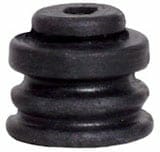When selecting a rubber material, EPDM vs natural rubber is a common comparison. Both materials offer durability and flexibility, but their resistance to environmental factors, heat, and mechanical stress determines which is best for your application.
EPDM (Ethylene Propylene Diene Monomer) is a synthetic rubber known for its exceptional weather, ozone, and UV resistance, making it ideal for outdoor applications. Natural rubber, on the other hand, is valued for its elasticity and tear resistance, making it a better fit for high-impact applications.
EPDM vs Natural Rubber: Properties & Resistance
The fundamental differences between EPDM rubber vs natural rubber lie in their physical properties, environmental resistance, and mechanical strength. Here’s how they compare:
Comparison of Material Properties
| Property | EPDM Rubber | Natural Rubber |
|---|---|---|
| Flexibility | High | Very High |
| Tear Resistance | Moderate | Excellent |
| Weather & UV Resistance | Excellent | Poor |
| Heat Resistance | Up to 350°F | Up to 175°F |
| Abrasion Resistance | Moderate | High |
| Oil & Chemical Resistance | Poor | Moderate |
- EPDM is highly resistant to UV exposure, ozone, and extreme temperatures, making it an excellent choice for outdoor environments.
- Natural rubber offers superior tear resistance and elasticity, making it ideal for applications requiring flexibility and impact absorption.
Environmental & Chemical Resistance
Both materials have different levels of resistance to weathering, chemicals, and extreme conditions.
- EPDM withstands UV rays, ozone, and moisture, making it the go-to choice for roofing, automotive seals, and outdoor gaskets. However, it degrades quickly in the presence of oils and solvents.
- Natural rubber has moderate weather resistance but performs better in applications requiring high tear strength and adhesion to metal.
Chemical Exposure:
EPDM performs well against alkalis, acids, and oxygenated solvents, while natural rubber is better suited for applications with mild oil and chemical exposure.
If your application involves long-term outdoor exposure, EPDM is the best option.
If your project requires tear resistance and flexibility, natural rubber is the superior choice.
Best Applications for EPDM and Natural Rubber
EPDM Rubber Applications
- Automotive Seals & Weather Stripping – Resists heat, moisture, and UV damage.
- Roofing & Waterproofing – Used in EPDM membranes for durable, leak-proof protection

- HVAC & Industrial Seals – Handles steam, water, and ozone exposure effectively.
- Outdoor Electrical Insulation – Protects against weather-related wear and tear.
Natural Rubber Applications
- Heavy-Duty Industrial Seals – Provides superior tear resistance and flexibility.
- Hoses & Gaskets – Used in applications requiring repeated stretching and compression.
- Shock Absorbers & Mounts – Offers elasticity and impact resistance.
- Adhesion to Metal Applications – Ideal for rubber-to-metal bonding needs.
Cost Considerations: Is Natural Rubber or EPDM More Affordable?
EPDM is generally more affordable, making it a cost-effective choice for roofing, seals, and outdoor applications.
Natural rubber tends to be slightly more expensive due to its superior tear strength and elasticity, but the cost is justified for applications requiring high durability and flexibility.
The right choice depends on balancing cost with performance needs—EPDM is budget-friendly for outdoor applications, while natural rubber offers unmatched elasticity and tear strength for demanding applications.

